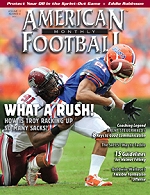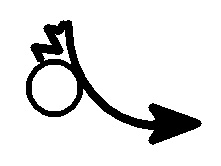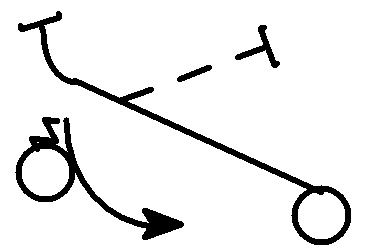Article CategoriesAFM Magazine
|
The Air Raid Quick Screen© More from this issueThe Air Raid Quick Screen By Shane Dular, Assistant Head Coach and Offensive Coordinator South Johnston High School (NC)
The quick screen is one of the signature plays of the air raid offense. One of the first plays installed by any air raid team from Texas Tech to Troy, the screen perfectly epitomizes the offense’s philosophy of “throw short to people who can score.” Television commentators love to say that the quick passing game counts as a run, but the statement rings true with the quick screen. The goal is three yards but the possibility always exists for the big play. The play is simple to install and modify for personnel and formations, and it can be called for any receiver. Receivers love the play because they know the ball is coming, it’s getting there fast, and they have a chance to do something special. We go into every game trying to run at least four quick screens in the first quarter and ten for the game. Hal Mumme used to say, “Throw them even when they don’t work because it will help in pass pro. In short, the quick screen is vital component of the air raid attack and can help any offense. Mechanics of the Screen Screen Receiver - The receiver getting the pass can work one of two releases. The basic release is used when the DB is giving some cushion in his alignment. At the snap, the receiver fires his feet and pumps his arms to simulate a hard vertical release. He jabs his outside foot and then uses it to push himself towards the quarterback. His hips should stay square as he bounces towards the quarterback. After catching the ball, the receiver is taught to get vertical, find a seam through the first line of blocking, and generally work to the outside. The bad guys are coming from the inside. We tell them to drive for five and then let God tell them what to do. If the receiver gets press coverage, then he will drive with an outside release for three steps and then re-trace to the quarterback very quickly. The idea is to make the DB turn away from the inside receiver for a second. The second receiver will drill the DB as the screen receiver will rub off the block.
Playside Receivers - This is the hardest position to teach and key to this play working. Every other block is a bonus. The receiver aims one yard in front of the screen receiver and must block the most dangerous defender, or MDD. In simplest terms, this is the defender that could get to the screen player first. We try to keep it that simple for him, but he must make this decision on the run. We are not looking for the big hit, but if the opportunity presents itself, we will take it. The blocking technique we use is to square up with the defender, drop and widen the base, and continually punch and chop feet while staying in front. Other playside receivers and offensive linemen will have the same aiming point and will start picking off defenders as they arrive. Receivers on the opposite side of the ball will stalk their defenders. Offensive Line –The playside tackle will step up with inside foot and then sprint to aiming point one yard in front of the screen receiver (Diagram 1). We tell them we want them to try and kick the corner or lead the receiver down the sideline. This is to get Diagram 1 his path right and not turn too soon. His real job is to get to his landmark and block the first wrong color. This is usually the second most dangerous defender. The playside guard will slam the defensive tackle and then take the same angle as the tackle. He is taught to block the first unblocked bad guy or lead up the alley. He tends to catch pursuing safeties or linebackers. The other three OL will drive block or pro the remaining defensive linemen as long as they can. Quarterback and Tailback - The QB has the easiest job - catch the snap and throw it as fast as he can. We don’t even let him find the laces. He should catch the snap, pop his feet, and get the ball gone. At least two defensive linemen are coming unblocked, so QB’s learn quickly to throw the ball quickly. The tailback helps protect the QB by taking a blitzing linebacker or stepping to the releasing guard to help chip the defensive tackle.
Variations - Some teams have a super athletic player at defensive end that is quick enough and/or big enough to knock the screen down or even take it out of the air and return it. There are two variations to combat this. The first is called TOE, for Tackle-On-End (Diagram 4).The tackle will drive-block the end and the tailback will take his job on
Diagram 2
Diagram 3 the screen. The second is SLAM which tells the tailback to slam the outside shoulder of the defensive end (Diagram 5). To view a few clips of the quick screen follow the link: https://www.youtube.com/watch?v=ZXY6QjqkVbo
About the Author: Shane Dular is currently the offensive coordinator and assistant head coach at South Johnston High School (NC). He previously coached the air raid offense for 15 years at high schools in both Georgia and North Carolina. Dular is a graduate of Valdosta State. |
|
| HOME |
MAGAZINE |
SUBSCRIBE | ONLINE COLUMNISTS | COACHING VIDEOS |
Copyright 2024, AmericanFootballMonthly.com
All Rights Reserved







